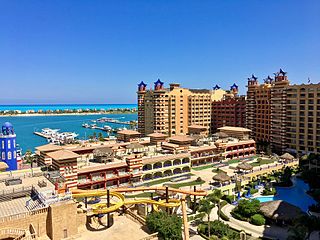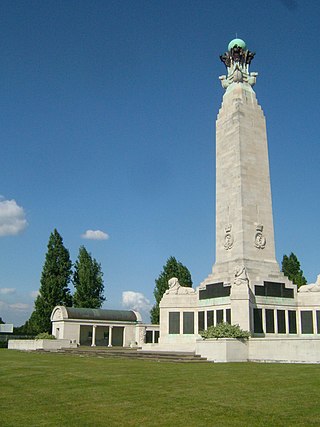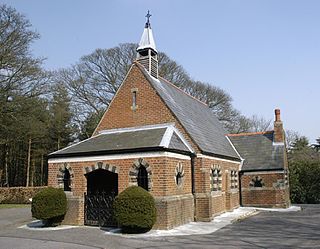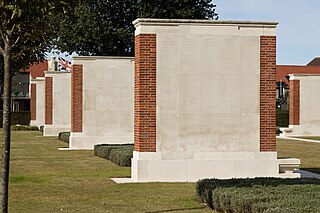
El Alamein is a town in the northern Matrouh Governorate of Egypt. Located on the Mediterranean Sea, it lies 106 kilometres (66 mi) west of Alexandria and 300 kilometres (186 mi) northwest of Cairo.

The Commonwealth War Graves Commission (CWGC) is an intergovernmental organisation of six independent member states whose principal function is to mark, record and maintain the graves and places of commemoration of Commonwealth of Nations military service members who died in the two World Wars. The commission is also responsible for commemorating Commonwealth civilians who died as a result of enemy action during the Second World War. The commission was founded by Sir Fabian Ware and constituted through Royal Charter in 1917 as the Imperial War Graves Commission. The change to the present name took place in 1960.

The Tower Hill Memorial is a pair of Commonwealth War Graves Commission memorials in Trinity Square Gardens, on Tower Hill in London, England. The memorials, one for the First World War and one for the Second, commemorate civilian, merchant seafarers and fishermen who were killed as a result of enemy action and have no known grave. The first, the Mercantile Marine War Memorial, was designed by Sir Edwin Lutyens and unveiled in 1928; the second, the Merchant Seamen's Memorial, was designed by Sir Edward Maufe and unveiled in 1955. A third memorial, commemorating merchant seamen who were killed in the 1982 Falklands War, was added to the site in 2005.

The Kranji War Cemetery is located in Kranji, Singapore, and is the final resting place for Allied soldiers who perished during the Battle of Singapore and the subsequent Japanese occupation of the island from 1942 to 1945 and in other parts of Southeast Asia during World War II.

Chatham Naval Memorial is a large obelisk situated in the town of Chatham, Kent, which is in the Medway Towns. The memorial is a feature of the Great Lines Heritage Park. The huge expanse of the Great Lines was in its own right a layer of defence to protect Chatham Dockyard from attack.

Aldershot Military Cemetery is a burial ground for military personnel, or ex-military personnel and their families, located in Aldershot Military Town, Hampshire.

The Cathays Cemetery is one of the main cemeteries of Cardiff, Wales. It is in the Cathays district of the city, about 1.5 miles (2.4 km) north of Cardiff city centre. At 110 acres it is the third largest cemetery in the United Kingdom. It is listed on the Cadw/ICOMOS Register of Parks and Gardens of Special Historic Interest in Wales.

The Loos Memorial is a World War I memorial forming the sides and rear of Dud Corner Cemetery, located near the commune of Loos-en-Gohelle, in the Pas-de-Calais département of France. The memorial lists 20,610 names of British and Commonwealth soldiers with no known grave who were killed in the area during and after the Battle of Loos, which started on 25 September 1915. This memorial covers the same sector of the front as the Le Touret Memorial, with each memorial commemorating the dead either side of the date of the start of the Battle of Loos.

The Bayeux War Cemetery is the largest Second World War cemetery of Commonwealth soldiers in France, located in Bayeux, Normandy. The cemetery contains 4,648 burials, mostly from the Invasion of Normandy. Opposite this cemetery stands the Bayeux Memorial which commemorates more than 1,800 casualties of the Commonwealth forces who died in Normandy and have no known grave.

Operation Checkmate was the codename for a raid on shipping at Haugesund, Norway in April 1943 during the Second World War by British Commandos. The raiding party consisted of seven men of No. 14 (Arctic) Commando who managed to sink one ship using limpet mines. While waiting in hiding for the transport back to the United Kingdom they were captured on 14 and 15 May 1943 and eventually taken to Sachsenhausen and Belsen concentration camps where six of them were executed, victims of the Commando Order. The seventh man died of typhus.

The Arras Flying Services Memorial Commonwealth War Graves Commission war memorial in the Faubourg d'Amiens Cemetery, Arras, France. The memorial commemorates nearly 1,000 airmen from forces of the Commonwealth who were killed on the Western Front during World War I and who have no known grave. The memorial was designed by Edwin Lutyens, sculpted by William Reid Dick and unveiled by Hugh Trenchard, 1st Viscount Trenchard, Marshal of the Royal Air Force on 31 July 1932.

The Helles Memorial is a Commonwealth War Graves Commission war memorial near Sedd el Bahr, in Turkey, on the headland at the tip of the Gallipoli peninsula overlooking the Dardanelles. It includes an obelisk which is over 30 metres (98 ft) high.

The Portsmouth Naval Memorial, sometimes known as Southsea Naval Memorial, is a war memorial in Portsmouth, Hampshire, England, on Southsea Common beside Clarence Esplanade, between Clarence Pier and Southsea Castle. The memorial commemorates approximately 25,000 British and Commonwealth sailors who were lost in the World Wars, around 10,000 sailors in the First World War, and 15,000 in the Second World War. The memorial features a central obelisk, with names of the dead on bronze plaques arranged around the memorial according to the year of death.

Northampton War Memorial, officially the Town and County War Memorial, is a First World War memorial on Wood Hill in the centre of Northampton, the county town of Northamptonshire, in central England. Designed by architect Sir Edwin Lutyens, it is a Stone of Remembrance flanked by twin obelisks draped with painted stone flags standing in a small garden in what was once part of the churchyard of All Saints' Church.

The Dunkirk Memorial is a Commonwealth War Graves Commission memorial to the missing that commemorates 4,505 missing dead of the British Expeditionary Force (BEF), most of whom fell prior to and during the Battle of Dunkirk in 1939 and 1940, in the fall of France during the Second World War.

Ralph Hobday OBE was a British architect who worked for the Commonwealth War Graves Commission.

The Kalkara Naval Cemetery is a cemetery in Kalkara in the South Eastern Region of Malta. The main entrance to the cemetery is at the junction of Triq Santa Rokku and Triq San Leonardu. The cemetery is divided into Protestant and Roman Catholic sections.
Walter Sidebottom was an English professional footballer who played as a winger in the Football League for Bolton Wanderers.

















